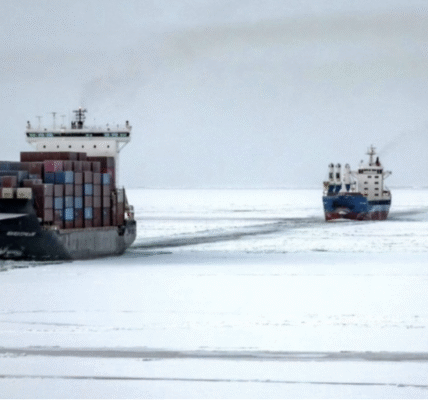
As a meeting of the International Maritime Organization’s Sub-Committee on Ship Design and Construction (SDC 10) opens today in London, the Clean Arctic Alliance is calling on the maritime sector to reduce the impact of underwater noise from shipping on Arctic wildlife.
According to Dr Sian Prior, Lead Advisor to the Clean Arctic Alliance, underwater noise levels from shipping are increasing in Arctic waters, threatening both Indigenous communities and wildlife who depend on marine resources for food – yet there is no regulation of this noise pollution. Up to now, the IMO has spent too long focusing on voluntary guidelines instead of moving to mandatory noise reduction measures.
During this week’s meeting, the IMO has the chance to put in place an action plan that includes formulating best practices for underwater noise management planning, experience-building to reduce underwater noise, and laying the groundwork for new policy, all important steps to moving towards mandatory measures that ensure noise pollution from ships is reduced throughout our oceans.
..he added.
SDC10
During SDC10, Clean Arctic Alliance specifically calls on the IMO member states to:
- Develop a recommended structure and a plan for the IMO’s Experience Building Phase (EBP). This could be accomplished by adding this task to the terms of reference for the proposed Working Group on the Review of the Guidelines.
- A new task be included in the proposed action plan directing SDC 10 to submit an information document to MEPC 82 (30 Sept – 4 Oct 2024) detailing the energy efficiency measures that provide underwater noise reduction benefits and those that offer no benefits or have a negative effect on underwater noise for consideration by MEPC in its revision of the Carbon Intensity Indicator (CII).
- During SDC 10, discuss and agree upon a recommendation that identifies an appropriate process for implementing the action plan in a timely manner, and seek approval of the recommendation by MEPC 81 (18 – 22 March 2024) as a matter of urgency.
- Support the inclusion of an Implementation Framework for the Guidelines for Underwater Radiated Noise Reduction in Inuit Nunaat and the Arctic. In a paper submitted to SDC 10, The Inuit Circumpolar Council is asking for a ‘how to’ document to be developed for ships to implement the Inuit Nunaat guidelines. As the Arctic is a special case there needs to be specific focus on ways ships can reduce noise, take into account Indigenous Knowledge and community perspectives, and protect fragile ecosystems.
About Underwater Noise:
For many marine organisms sound is the most important means of communication. Under water, vision is restricted and without good hearing ability, elementary functions such as navigating, finding prey and partners can be hampered. This is of particular importance for marine mammals, and also for fish and even invertebrates.
As explained, the Arctic has been almost free of anthropogenic (human-sourced) sound for a long time, but with increased human activity, the Arctic Ocean is becoming more noisy every year. An important source of continuous noise is shipping, specifically from propellers and engines. Since shipping has increased substantially during recent decades, underwater noise is a growing problem, contributing to serious impact on the Arctic ecosystem.
According to a study by Transport Canada, the World Maritime University and WWF, the existing guidelines have not been effective in reducing underwater noise, namely because of their voluntary, non-regulatory nature. Research from the Arctic Council has shown that Arctic underwater noise has significantly increased in recent years. Ship traffic is also increasing in the Arctic, and given the unique special Arctic environment, underwater noise from ships has a much higher impact than in other parts of the global ocean.
The most important source of continuous underwater noise in shipping is cavitation, or production of vacuum bubbles by propellers. The noise produced by this process leads to masking, where the frequency of ship noise overlaps with sound produced and used by marine mammals.
International Policy
The International Maritime Organization adopted voluntary guidelines for underwater noise in 2014. There are no signs that these guidelines have had any effect and in June 2021 the IMO agreed to “commence further work on underwater noise from ships”.
Revised Guidelines for the reduction of underwater noise from commercial shipping (MEPC.1/Circ.906) were approved in 2023 to address the adverse impacts on marine life. A three year experience building phase in using the guidelines was agreed and a complementary action plan which includes actions to increase awareness and uptake of the guidelines. In addition, Guidelines for underwater radiated noise reduction in Inuit Nunaat and the Arctic, developed by the Inuit Circumpolar Council have also been approved.
Since worldwide regulations to mitigate continuous underwater noise by ships are currently not in place, noise mitigation measures are only applied in certain situations or for specific purposes.





I loved even more than you will get done right here. The overall look is nice, and the writing is stylish, but there’s something off about the way you write that makes me think that you should be careful what you say next. I will definitely be back again and again if you protect this hike.
Thanks I have just been looking for information about this subject for a long time and yours is the best Ive discovered till now However what in regards to the bottom line Are you certain in regards to the supply
Nice blog here Also your site loads up fast What host are you using Can I get your affiliate link to your host I wish my web site loaded up as quickly as yours lol